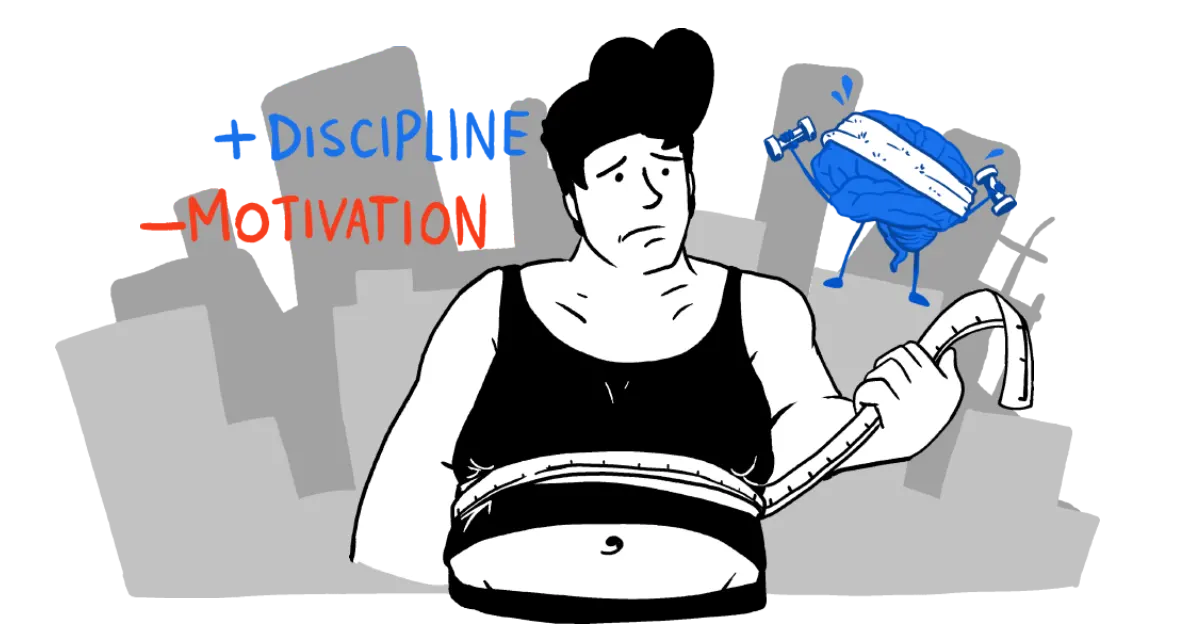
Losing weight is not for the faint-hearted – in fact, 50% of people give up their diets within 2 months of starting them.1 Trading in cookies and the television remote for carrot sticks and tennis shoes can be discouraging.
However, plenty of people lose weight successfully, despite the obstacles… It’s all about getting into the right mindset. Studies suggest that optimism may play a role in achieving and maintaining long-term weight loss.2
If you’re considering giving up on weight loss, read this article first. Here are the 5 tested-and-proven steps you can take to alter your mindset and get into a steady rhythm of healthy habits.
1. Don’t be Your Own Drill Sergeant (Forgive Yourself)
If you’re wondering how to not give up on a diet, the first step is clear: Forgive yourself. Don’t be fooled by social media – no human is perfect. Even if you follow the healthiest trending diets, you still might eat the donut, sleep in, skip that workout class, or hit a weight loss plateau.
Practice Self-Compassion: If you’re thinking of giving up on weight loss, it’s time to learn self-compassion. Self-compassion activates our parasympathetic nervous system and decreases our sympathetic response, releasing oxytocin and opiates. While your immediate response to overeating may be entering a fight-or-flight mindset, it’s not a healthy or productive response. Instead, self-compassion is good for your physical and mental health. It decreases depression, anxiety, and stress.3 People who practice self-compassion report fewer colds, aches, and pains and increased long-term motivation. Here are a couple of effective ways to practice self-compassion when you cheat on your diet:
- Comfort your body by eating a healthy snack, resting, massaging your feet, or doing anything else that nourishes you.
- Write a letter to yourself. Describe the problem and write encouragement to yourself as if you were writing to a friend.
- Get excited about the future. Making positive plans, like eating a delicious and healthy meal before a party, will result in a more positive mindset and significantly more weight loss.4
Practice Mindfulness: Try to observe your own thoughts, feelings, and actions from an objective perspective. Instead of trying to suppress them, accept the bad with the good. Meditation and yoga can be good ways to introduce the power of mindfulness into your life.
Address Depression and Anxiety: As you practice mindfulness and self-compassion, you may notice some underlying mental challenges like depression or anxiety. Beginning Cognitive Behavioral Therapy with a licensed therapist can help you break those negative patterns of thought.
2. Envision & Remind Yourself Why You Want to Lose Weight
To stay focused on your health goals, identify a clear purpose for wanting to lose weight, whether it’s to live a longer life, gain more confidence at work, or have more energy. Regularly remind yourself of this purpose to maintain your motivation.
Then envision what the future holds if you adopt healthy eating. Imagine feeling confident in a specific outfit. Imagine feeling self-assured during a work presentation. Imagine being in a better mood all the time.
Create your vision, believe in your vision, and review it daily.
There are many coaching methods, including a method called FIT, that teaches dieters to fully visualize achieving their weight loss goal. One study published in the International Journal of Obesity showed that out of 141 people, those who used visualization lost five times more weight on average than those who did not use visualization techniques. Here’s how to do it at home:
Visualize your future: Spend 20 minutes reflecting on how losing weight could enhance your life. Consider writing down your desired appearance and how you want to feel. Engage all your senses—imagine the sensation of eating fresh, healthy food and visualize yourself wearing a bathing suit with confidence.
Set aside time each week: Set aside 10-20 minutes each week to evaluate your progress and envision your future. Set an alarm on your phone so you don’t miss your visualization appointment.5
3. Drop The All or Nothing Mindset

Many people abandon their weight loss efforts because they set unrealistic expectations, like promising to work out for two hours every day, completely cutting out sugar, and counting every calorie. This often leads to them feeling sore, starving, and miserable.
The all-or-nothing mindset is characterized by:
- Saying you have to run a mile when just running a few minutes is a good start.
- A cold Diet Coke every time I’m thirsty, or no Diet Coke ever.
- Eating vegetables at every meal, or eating vegetables once a week.
- A huge dessert every night, or no treats ever.
The problem with this thinking is that when you inevitably break your “nothing” streak and dig into some chocolate, your brain will release a waterfall of dopamine and other feel-good neurotransmitters. This mental reward will cause us to indulge even more than we would have before our diet.
What really helps in sticking to a diet is taking baby steps.
Stop telling yourself you failed if you eat a piece of cake. It doesn’t have to be all or nothing. Instead, try implementing baby steps like:
- Figuring out how much you should run to lose weight. We suggest starting small with a 2 minute walk, then jog 2 minutes for a total of 15 minutes on Mondays and Saturdays.
- Do just 3 reps of 2 different exercises in the gym. Try to go 2 times per week for your short workout.
- Eat the same dinners that you love – just substitute 1/3 of your plate with some veggies that you like.
Once you get into the groove of eating better or exercising, you’ll likely want to eat more healthy foods or workout longer. But no matter what, be sure to keep up with the bare minimum.
4. Don’t Rely On Motivation
If an occasional spurt of motivation was enough to fuel long-term weight loss, no one would ever give up on weight loss and everyone would be thin! You’re not the only one who has Googled up some “motivation to stick to diet.” Motivation fuels a successful diet, but nobody has motivation ALL the time. Discipline is more effective than motivation, but NOT that drill sergeant discipline – just planning, execution, and consistency.
To develop discipline:
- Identify what you want and the reasons WHY you want it—the more specific, the better.
- Get to know yourself – your capabilities, preferences, dreams and goals, and how they all align.
- Create a plan that you love. It should include foods, exercises, and a whole lifestyle you really enjoy that will steadily bring you closer to your weight loss goals.
- Take time each morning to connect to your goals and purposes (see step 1).
- Forgive yourself for the small losses, and celebrate the small wins (like grabbing a water bottle instead of a soda). Positive self-talk is key.
- Make adjustments as needed. Our lives change every day. A plan that works for you today might not work in three weeks. You get to write your own script!
Quick Ways to Regain Motivation After Giving Up on Weight Loss
Discipline is the longer-lasting solution than motivation, but these strategies can help you as you tweak your plans or revisit your reasons for losing weight.
- Quiz Yourself. Ask yourself questions about when you stop dieting, like how would you feel two months from now if you quit.
- Figure Out What’s Not Working. If you’re craving more chocolate and don’t have time to exercise, try finding healthier chocolate recipes and purchasing the ingredients to make them. Drop the hour-long workouts and pick up 20-minute morning walks instead.
- Stop Comparing Yourself. You might think that comparing yourself to supermodels on social media is a good idea, but it can actually make you feel negative about yourself and deter your progress.
- Establish Some Rewards. Plan a special trip, take a day off work, or make a special purchase when you reach certain milestones.
- Don’t Wait “Until You Lose Weight.” Don’t put your whole life on hold until you lose weight. Go to your 10-year high school reunion, plan that girl’s trip, or enroll in that dance class, all while you’re losing weight.
- Establish a Support System. Join a team-based weight loss competition, ask for motivating texts from loved ones, or join an encouraging weight loss group.
Extrinsic Motivation vs. Intrinsic Motivation
Extrinsic motivation has no staying power. People who are extrinsically motivated lose weight in the short term, only to gain weight back again. Guilt avoidance or people pleasing are not effective long-term.
Intrinsic motivation involves emotions like interest, enjoyment, and challenge. It’s about enjoying the journey, not just paddling desperately towards the results. According to self-determination theory in psychology, you can cultivate intrinsic motivation by feeling competent and autonomous. So, while a support network is important, don’t overly rely on your network to motivate you. The best kind of motivation comes from within.6
5. Build Habits & Set Yourself Up for Success
When you have good habits in place, you’re much less likely to give up on your diet. Part of your lifestyle change will be building good habits like:
- Starting the day with a healthy breakfast
- Going to bed earlier
- Snacking on nuts and berries
- Implementing positive self-talk
- Finding a new stress outlet besides eating (like painting, walking or calling a friend)
If you’re still figuring out how to stay on track with a diet, it’s time to learn more about habit-forming. James Clear, author of the book Atomic Habits says, “A habit is a behavior that has been repeated enough times to become automatic.”7 He supplies some ideas for picking up new habits:
- Make it obvious by leaving your running shoes out where you can see them and placing reminders around your home or on your phone.
- To make an activity more appealing, combine something you want to do with something you need to do. For instance, you could call your sister during your daily walk or post a photo of your healthy dinner on Instagram.
- Make it easier on yourself by reducing the steps between you and your good habits. Prepare your environment by stocking your fridge and cupboard with plenty of healthy foods. Opt to work out in your backyard instead of driving 20 minutes to the gym.
- To make it satisfying, reward yourself immediately after completing your habit with positive self-talk.
By making weight loss obvious, attractive, easy, and satisfying, you can stay focused on weight loss and start making some big changes.
Weight Loss Points of Focus
When you have the right mindset, you’re ready to hone in on your weight loss goals. With so many diets and weight loss concepts online, it’s easy to lose focus on what really matters; setting smart goals, exercising and eating better. These are some of the things that will help you succeed on your weight loss journey.
Eat Better & Avoid Diet Mentality

First and foremost, remember that you don’t have to change your life overnight. Make small substitutions and changes in order to avoid fad diet mentality or becoming obsessed with weight.
- Bring healthy snacks to work – salted nuts instead of potato chips
- Substitute just the unhealthiest thing you eat or drink with something healthier
- Try infused water or Gatorade Zero instead of soda
- Eat out only 2x per week instead of 3x
- Donate your least healthy foods to a foodbank
Remember, diet mentality is unhealthy and does not lead to long-term success. Here are some ways to reject diet mentality and instead focus on creating a healthier life for yourself.
- Eat some of your favorite cuisines this week, even if it’s not “healthy.” It’s about progress, not perfection.
- Don’t weigh yourself today, all week, or all month if you can help it.
- Unfollow anyone on social media who gives you unrealistic expectations for your body.
- Meditate and repeat to yourself “I am more than just my body shape or size.” Write down all of the things that make you valuable.
Exercise
The only way to make exercise a lifetime habit is by doing exercise you enjoy. Here are some ideas that may spark inspiration:
- Jogging or running: Even if it’s just around the block. Find a buddy, alternate walking with jogging, download some amazing music, or sign up for a local 5K. A 2015 review found that running was highly effective for weight loss.8
- Cycling: You can do it in a gym or outdoors. You can even use it as a mode of transport to get to work or take the kids or pets on a ride.
- Resistance exercise: There are so many bodyweight exercises available on YouTube, so you can do them in the comfort of your own home. Building muscle will increase your resting metabolic rate so you can constantly burn more calories.
- Swimming: Swimming has a low risk of injury or strain, and research suggests it is one of the best forms of exercise for burning calories.9
Other ideas include dancing, jumping rope, kayaking, stairs, yoga, tennis, and Frisbee, among many others.
Set SMART Goals
If you ever find yourself considering giving up on weight loss, it’s time to revisit your goals. If you want to stay on track, a vague goal like “I will eat a more balanced diet in the new year” won’t get you far.
A SMART weight loss goal is Specific, Measurable, Achievable, Results-Focused, and Timely. Here are a few examples:
- I will go on a walk on Mondays and Fridays around my neighborhood for 30 minutes to lose 2 pounds by June 1.
- I will add a green or orange vegetable to my work lunch on Monday, Tuesday, and Wednesday, which I will prepare on Sunday evening to help me lose 2 pounds by Feb 28.
- I will replace soda on 9 out of 10 occasions for sparkling water, and drink one soda on Sunday afternoons until March 20 to increase my hydration and decrease caloric intake.
It’s About Much More Than Being Thin — Never Give Up
Giving up on weight loss happens when you have a dieting mindset or once you’ve quit trying. According to Confucius, “It does not matter how slowly you go, as long as you don’t stop.” Just a little more portion control, walking once a week, or eating more intuitively will make all the difference in how you look and feel.
Instead of focusing on what to give up to lose weight, find ways to enrich your life with healthy habits. Use visualization, take baby steps, and celebrate your successes. Do whatever it takes to make your new habits enjoyable for you – when you love your new life, you’ll achieve long-lasting weight loss!
References
1Amigo, I., & Fernández, C. (2007). Effects of diets and their role in weight control. Psychology, Health & Medicine, 12(3), 321–327. <https://doi.org/10.1080/13548500600621545>
2Elfhag, K., & Rossner, S. (2005). Who succeeds in maintaining weight loss? A conceptual review of factors associated with weight loss maintenance and weight regain. Obesity Reviews, 6(1), 67–85. <https://doi.org/10.1111/j.1467-789x.2005.00170.x>
3Harvard Health. (2013, June 27). The power of self-compassion. Retrieved January 6, 2022, from <https://www.health.harvard.edu/healthbeat/the-power-of-self-compassion>
4Gierut, K. J., Pecora, K. M., & Kirschenbaum, D. S. (2012). Highly Successful Weight Control by Formerly Obese Adolescents: A Qualitative Test of the Healthy Obsession Model. Childhood Obesity, 8(5), 455–465. <https://doi.org/10.1089/chi.2011.0101>
5Solbrig, L., Whalley, B., Kavanagh, D. J., May, J., Parkin, T., Jones, R., & Andrade, J. (2018). Functional imagery training versus motivational interviewing for weight loss: a randomised controlled trial of brief individual interventions for overweight and obesity. International Journal of Obesity, 43(4), 883–894. <https://doi.org/10.1038/s41366-018-0122-1>
6Ryan, Richard M., and Edward L. Deci. “Self-Determination Theory and the Facilitation of Intrinsic Motivation, Social Development, and Well-Being.” American Psychologist, vol. 55, no. 1, Jan. 2000, <https://pubmed.ncbi.nlm.nih.gov/11392867/>
7Clear, J., Sethi, R., Dweck, G. K. D. C., Dweck, C. B. M. S., 978–0345472328, Sethi, R. B. R. B. T. Y. T. W. I., 978–1523505746, Clear, A. H. B. J., 978–1847941831, Keller, O. T. B. G., & 978–1848549258. (2022). Atomic Habits, I Will Teach You To Be Rich, Mindset, The One Thing 4 Books Collection Set. Random House Business/Yellow Kite/Robinson/John Murray Learning.
8Hespanhol Junior, L. C., Pillay, J. D., van Mechelen, W., & Verhagen, E. (2015). Meta-Analyses of the Effects of Habitual Running on Indices of Health in Physically Inactive Adults. Sports Medicine, 45(10), 1455–1468 <https://doi.org/10.1007/s40279-015-0359-y>
9Harvard Health. (2021, March 8). Calories burned in 30 minutes for people of three different weights. Retrieved January 6, 2022, from <https://www.health.harvard.edu/diet-and-weight-loss/calories-burned-in-30-minutes-for-people-of-three-different-weights>